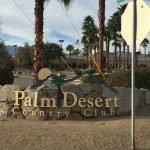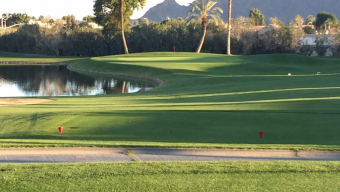PALM DESERT, Calif. — Among the 120-plus golf courses currently operating in the Coachella Valley, Palm Desert Country Club has a special place in history — one of the first courses carved out of dirt, sand, trees and desert plants.
It opened in 1962 and has been on a rather wild ride ever since.
Palm Desert CC was so good at a young age that it hosted the Bob Hope Desert Classic qualifying tournament (called “Hope Fore Tomorrow”) in the 1970s, providing a springboard to stardom for the likes of World Golf Hall of Famer Tom Kite.
It was so bad in the early 2000s that the fairways were basically dirt and weeds and the clubhouse was on the verge of being condemned. In 2007, the once-proud facility was on life-support.
But look at her now.
After two productive ownership changes in the past 10 years, the 6,357-yard, Par 72 facility is back to its glory days.
A company out of Vancouver, British Columbia purchased the property in August, 2011, spent five months getting the 18-hole layout ready for play, and opened the doors to a refurbished clubhouse in January, 2012.
The good-old days for the old-school course returned to rave reviews and despite the recent three-year drought that resulted in more than 30 acres of turf being removed and replaced by desert plants, the past five-plus years have seen a steady climb back to where the course was in the beginning.
Under the leadership of general manager Wilf Weinkauf, Palm Desert CC has become one of the most popular courses in the valley. Again.
Weinkauf, who has 30 years of experience in the golf industry, previously was the developer, co-owner and general manager of Northern Bear Golf Club in Alberta, Canada — a Jack Nicklaus signature course.

Palm Desert CC entrance
Also coming south was Ted Genereux, the Palm Desert CC Golf Course Superintendent since the fall of 2012. He previously worked on the construction of Northern Bear GC and stayed on to operate the maintenance program for more than 10 years.
He obviously knows a lot about growing grass in a desert.
Seeing is believing.
“The course is in fantastic shape this year,” said Dave Zickau, the Palm Desert CC Director of Golf. “It’s the best I’ve seen it in the six years I’ve been here.”
Bummed by a typical wet and cold January in Seattle, my wife, father-in-law and I decided to spend two weeks in the Palm Springs area, where rain is rare and the temperature consistently is in the 70-plus degree range.
Our rental house, via VRBO, was located opposite the No. 1 green at Palm Desert CC. A gated fence provided easy access to the public course for some early-evening short-game practice.
Besides the close proximity to the course, there is so much more that makes this a must-play when you visit.
Every fairway is absolutely lush. The majority of greens are large, fast and fair. The staff hospitality is top-notch.
And the price? It’s a bargain.
The vastness of greenery begins on the first hole, a 480-yard par-5 (from the white tees) slight dogleg right with houses on both sides of an expansive fairway that is so wide that it’s difficult to miss. During the four rounds I played there, only one house was hit by an errant shot – and I wasn’t the culprit.

My 95-year-old caddie
The course meanders through a neighborhood of houses built in the 1960s along with modern condos and desert-style homes. Distances from green to tee on some holes are so far that taking a cart is required.
“We get a lot of comments about the condition of the course,” Zickau said, “but what people really like is that the golf course is very fair and easy to play. It is not overly long. We can stretch out to about 6,400 yards which isn’t long compared to other places. But a lot of players like it because anybody can play it. It’s a fair course for all players and that’s why they like it.”
Many of the newer courses in this area also are surrounded by homes but the margin of error is much smaller.
“I hear people talk about playing other courses in the valley and how they are lined with houses and condos much closer than our (course),” Zickau added. “That can be very intimidating.
“The front nine is wide open and when you get to the back (nine), you get some great views of the mountains. It gets a little on the tighter side, but it’s still fairly wide open, more so than some of the other courses in the valley, and that’s what golfers like.”
When you combine the weather, the condition of the course, the scenery and the price to play, you can understand why there are were close to 30,000 rounds played at Palm Desert CC in each of the past couple of years.
“We are probably one of the few courses that is still holding steady compared to the year prior,” Zickau said. “Our price is good. It’s a good value.”
He said about 75 percent of those 30,000 rounds are played from late October to the end of April.
As for the summer. . .”We pay people to play,” he laughed.
Actually, it goes down to $25 or $30 per round.
Although the course is relatively short by today’s standards, where some stretch out to more than 7,000 yards, this gem in the desert offers plenty of challenges — water comes into play on the 4th, 8th, 9th, 16th and 18th holes.
About the only thing Palm Desert CC doesn’t have is a driving range. Not a problem. The starter on No. 1 is quick to point out that a practice tee shot is just fine.

The unique 9th and 18th greens
The 9th and 18th holes are among the most memorable – and most photographed – on the course. They are divided by a spectacular waterfall display, utilizing water, rocks and desert vegetation.
The 16th is another picturesque hole. It’s a 156-yard par 3 with a large pond on the left side of the green. Four of my tee shots found a final resting place – in the pond.
My favorite hole?
That would be the 373-yard par 4 10th. I recorded a “4” in each of the four rounds I played.





















